With astounding spring blooms and moderate overall size, a dwarf magnolia tree is one of the most beautiful and manageable plants you can grow in your garden. But if you choose to raise one of these lovely plants, you should start by knowing the details of what it takes to do so. This article will help you out by covering the basics of how to grow and care for a dwarf magnolia tree.
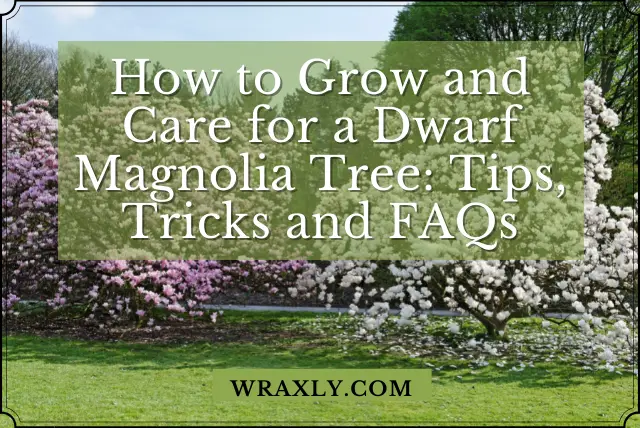
Table of contents
Know Which Type of Dwarf Magnolia You Have
Although many gardeners may use the term loosely, the name “dwarf magnolia tree” does not refer to a specific tree species. Instead, there are numerous types of dwarf magnolia varieties that you can choose to grow. And knowing which variety you have is the first step towards understanding how to care for it the right way. Here are a few of the most popular dwarf magnolia trees you’re likely to encounter:
- Magnolia grandiflora ‘Little Gem’, little gem magnolia tree
- Magnolia x ‘Jane,’ Jane magnolia tree
- Magnolia stellata ‘Royal Star,’ royal star magnolia
- Magnolia x soulangeana ‘Lilliputian,’ saucer magnolia
- Magnolia’ Butterflies’, butterflies magnolia
There are plenty of other magnolias that develop into a small tree. However, the ones above are some of the most common ones. Choose a variety based on the USDA zones in which it thrives, and the ornamental features you like most. Once you select, you’ll be ready to consider the general conditions these plants need to survive.
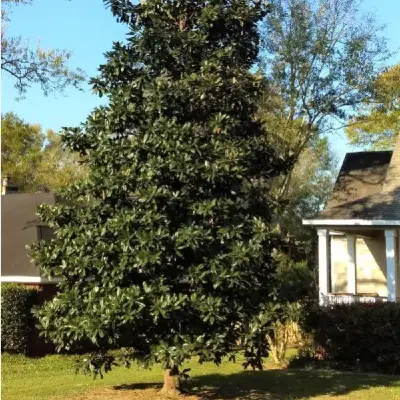
Little Gem Magnolia Tree
- Dwarf Flowering Magnolia Works in Smaller Modern Yards
- Beautifully Shaped Narrow Pyramidal Tree
- Fragrant, Waxy White Flowers Bring a Tropical Look and Sweet Scent
- Extravagant Bloom Production in Early Summer
- Sporadic Blooms Through Fall
- Elegant, Bi-Colored Lustrous Green and Bronze Brown Leaves
General Growing Conditions and Care for Dwarf Magnolias
Although there are several different types of dwarf magnolia trees you can plant in your yard, many of these varieties share similar growing requirements. These similarities make it relatively easy to generalize the conditions and care most dwarf magnolia trees need. The following sections will introduce you to the key factors you must remember if you want to keep your dwarf magnolia as healthy as can be.
Sunlight Needs for Dwarf Magnolia Trees
In most cases, a dwarf magnolia tree will prefer full sun exposure. However, these plants can often survive with a partial shade. A few hours of shade are most important in hot climates where full sun all day could damage the plant. Still, about six hours or more of direct sunlight will provide the best growing conditions in most locations.
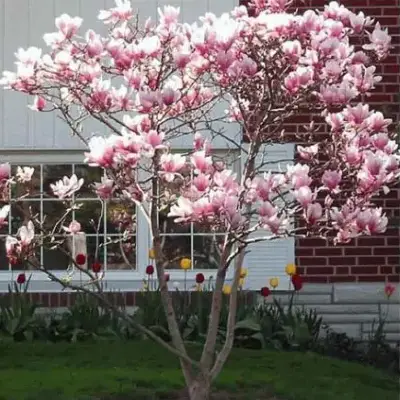
Jane Magnolia Tree
- Beautiful, Fragrant Spring Flowers
- Small Tree or Large Hedge
- Blooms a Bit Later Than Other Magnolias
- Full Sun
- Long Lasting
- Reddish-Purple Tulip-Shaped Blooms
Soil Conditions for Dwarf Magnolia Trees
Dwarf magnolia trees will do best in moist soil but with excellent drainage. Loamy soil is often the best variety to achieve those two characteristics. Your dwarf magnolia tree should also grow in acidic soils that have plenty of organic nutrients.
How to Plant a Dwarf Magnolia Tree
If you find an area that meets the sunlight and soil needs of a dwarf magnolia tree, you’re just about ready to start planting. Generally, planting a dwarf magnolia tree is like planting any other tree. Begin by digging a planting hole that is as deep as the root ball is tall and is significantly wider than the root ball to accommodate the shallow, spreading root system. Backfill with healthy soil, cover the area with a layer of mulch, and supply plenty of water just after planting.
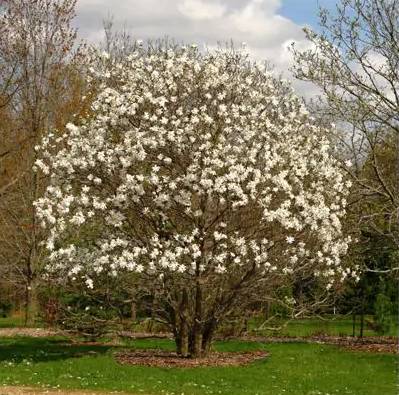
Royal Star Magnolia Tree
- Fragrant White Flowers in Early Spring
- Can Used as a Shrub or Small Tree
- Lovely, Glossy Foliage
- Excellent Form
- Pest and Disease Resistant
- Blooms Later to Resist Frost Damage
Watering a Dwarf Magnolia Tree
New dwarf magnolia trees should receive water three to four times each week. After a few months of healthy growth, reduce your regular watering schedule to one to two times per week. Once your dwarf magnolia is a bit older, it will have a stronger ability to withstand dry conditions. At this point you will need supplemental water just once per week during the hottest parts of the growing season.
Fertilizing a Dwarf Magnolia Tree
Fertilize your dwarf magnolia tree about three times per year after it has become established. Apply a slow-release fertilizer once in early spring, once in mid to late spring, and once again in the middle of summer. A general-purpose fertilizer will typically work well. However, dwarf magnolia trees like acidic soil so they can also benefit from blends that have higher nitrogen and those that increase the acidity of the soil.
Recommended Fertilizers for Dwarf Magnolia Trees
| Image | Title | Prime | Buy |
|---|---|---|---|
 | Thanos TreeHelp Premium Fertilizer for Magnolia | Prime | Check Price on Amazon |
 | TreeHelp Annual Care Kit for Magnolia | Prime | Check Price on Amazon |
Top | Purely Organic Tree & Shrub Fertilizer Plant Food Spikes (Box of 6 Spikes) | PrimeEligible | Check Price on Amazon |
 | Scotts Evergreen Flowering Tree & Shrub Continuous Release Plant Food | PrimeEligible | Check Price on Amazon |
 | Jobe's 01660 Fertilizer Tree & Shrubs, Includes 15 Spikes, 14 Ounces, Brown | PrimeEligible | Check Price on Amazon |
 | BioAdvanced 701915A 12 Month Tree and Shrub Feed Fertilizer with Insect Protection, 1-Gallon, Concentrate | PrimeEligible | Check Price on Amazon |
Pruning a Dwarf Magnolia Tree
The best time to prune a dwarf magnolia tree is during the late summer or the early fall. When you prune, aim to remove any branches that are dead, diseased, damaged, or crossing one another. Use sterile pruning tools and ensure that you don’t remove more than one-third of the tree’s total canopy size during a single pruning job.
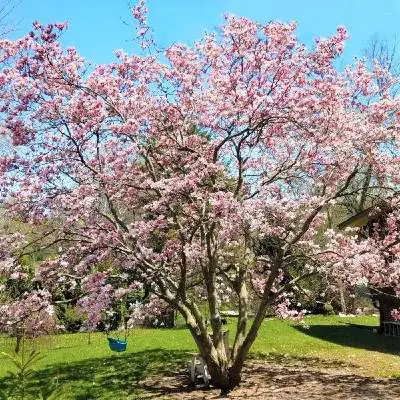
Saucer Magnolia Tree
- Unique Spring Display
- Large, Unique Blooms
- Pink & White Flowers
- Cup-Shaped Flowers
- Symmetrical Form
- Great Fall Color
A Few More Tips for Dwarf Magnolia Tree Care
The preceding sections should give you a solid understanding of what dwarf magnolia trees need to survive. However, there remain a few important points you should become familiar with before you plant one of these small trees.
Winter Wind Protection
As is the case with many trees that bloom in the early spring, it is wise to give your dwarf magnolia tree some wind protection. When a late winter storm arrives, it can easily damage the fragile flower buds that are just beginning to open. Wind protection will keep those buds intact and allow your plant to showcase its greatest ornamental feature.
Overall Slow Growth
At times, growing a dwarf magnolia tree can be frustrating. These plants are known to be slow growers. This means you’ll need to wait several years before they reach a considerable size. The best way to encourage growth is to give your dwarf magnolia tree ideal growing conditions. This includes plenty of sun, moist soil with great drainage, and low soil ph.
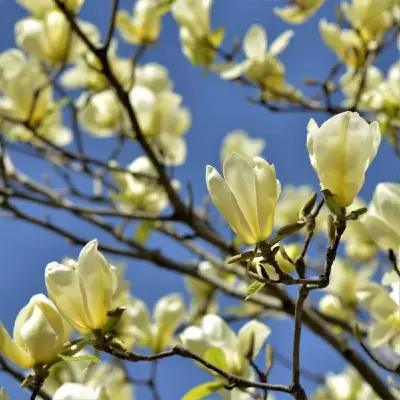
Butterfly Magnolia Tree
- Gorgeous Canary Yellow
- Double Blooms Each Spring
- Captivating Single Stem Tree Form
- Addictive Sweet Fragrance
- Absolutely Adored by Pollinators
- Lovely Pyramidal Shape
Timing for Planting
Planting time is also important to the development of a dwarf magnolia tree, and the type you have dictates which timing is best. Some magnolias are deciduous trees and should go in the ground while dormant in the late fall or winter. Evergreen magnolia trees will often survive better if you plant them in the early spring when they are out of their dormant phase.
Frequently Asked Questions about Dwarf Magnolia Tree Care
The dwarf magnolia tree grows slowly, at a rate of about 10 inches per year. They typically reach a height of about 15 feet and a spread of 8-10 feet.
Yes, the dwarf magnolia tree is an excellent choice for screening due to its dense foliage.
The roots of the little gem magnolia can be intrusive, and if they are too close to the foundation of your house, they may cause cracking or other damage. For this reason, it is generally recommended that you plant the tree at least 10 feet away from your house. This will give the roots plenty of room to grow without causing any damage to your property.
It could be due to drought stress, too much sun, or too much fertilizer.
It could be due to stress from too much heat, cold, or wind. It could also be due to a disease or insect infestation.
The dwarf magnolia tree is native to the southeastern United States. It is typically found in woodlands, swamps, and bottomland forests.
Final Thoughts on Dwarf Magnolia Tree Care
Southern magnolia trees come in many different varieties, including dwarf versions that are incredibly attractive and can fit in relatively small planting spaces. If you feel one of these plants would be the perfect addition to your property, consider the advice we’ve laid out in the article above. A review of this information will set you on the right track toward adding an impressive dwarf magnolia to your garden.

John Haryasz is a freelance writer and landscape designer. In the field of landscape architecture, he has contributed to many successful design projects throughout the country. As a writer, John specializes in creating captivating and informative web content. Through that work, he aims to share his design knowledge and promote engagement with the outdoor world.

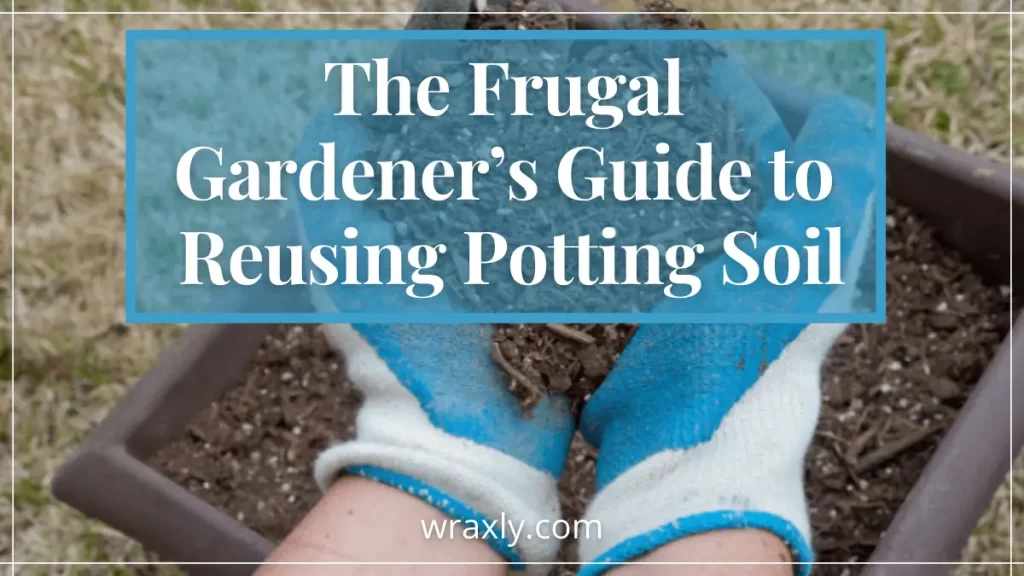

![10 Common Container Garden Mistakes to Avoid [Beginner’s Guide]](https://wraxly.com/wp-content/uploads/2021/02/10-Common-Container-Garden-Mistakes-to-Avoid-Beginners-Guide-1200-1024x576.webp)
